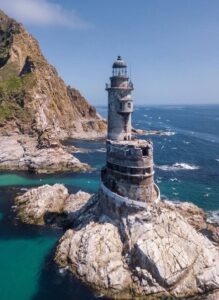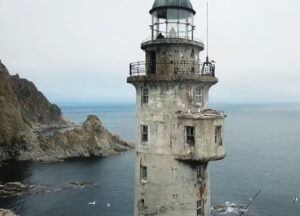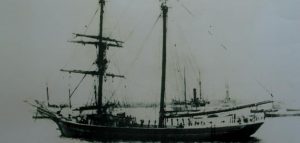abandoned
 I like lighthouses. That is just a fact. I am particularly fascinated with unusual lighthouse. There are many lighthouses all over the world. They are, of course, used to direct ships away from shallow waters or dangerous rocks that lurk below the surface of the water. Today, there are more than 21,600 lighthouses worldwide, and there are a few that are still in use. In pre-GPS days, they played a vital role in the shipping industry, but these days they are usually used as tourist attractions. Many are privately owned, and are only used in an extreme emergency, when the electronic guidance systems are down. Some lighthouses are simply abandoned. I have mixed feelings about those, because when abandoned, they usually fall into disrepair, but there is something about abandoned buildings that has always intrigued me…even when they have fallen into disrepair.
I like lighthouses. That is just a fact. I am particularly fascinated with unusual lighthouse. There are many lighthouses all over the world. They are, of course, used to direct ships away from shallow waters or dangerous rocks that lurk below the surface of the water. Today, there are more than 21,600 lighthouses worldwide, and there are a few that are still in use. In pre-GPS days, they played a vital role in the shipping industry, but these days they are usually used as tourist attractions. Many are privately owned, and are only used in an extreme emergency, when the electronic guidance systems are down. Some lighthouses are simply abandoned. I have mixed feelings about those, because when abandoned, they usually fall into disrepair, but there is something about abandoned buildings that has always intrigued me…even when they have fallen into disrepair.
One such unusual, abandoned lighthouse is the Aniva Lighthouse in Sakhalin, Russia. The lighthouse is situated on a small rock called Sivuchya near the rocky Cape Aniva. It is difficult to reach, and can only be accessed by water. To make matters worse, the tides are strong there. Still, the breathtaking scenery makes the journey worth while. Construction started on Aniva Lighthouse in June 1937 and finished in October 1939, taking just over two years. Building this navigational structure was difficult: all of the construction materials had to be delivered by water. Severe weather conditions didn’t make the process any easier.
When I first saw a picture on the Aniva Lighthouse, it reminded me of the front of a ship. It almost looked like a  shipwreck, except for the lighthouse part, of course. Upon closer inspection, the lighthouse really doesn’t look like a ship at all, but maybe it was designed to give that illusion. The concrete tower, is painted to match the surrounding rocks, its stroboscopic lamp located 131 above the ground. The structure is round in shape and equipped with a bay window, the 9-floor tower stands on an oval base, which looks like it is coming out of the coastal rocks. Maybe that’s why it looks like a ship.
shipwreck, except for the lighthouse part, of course. Upon closer inspection, the lighthouse really doesn’t look like a ship at all, but maybe it was designed to give that illusion. The concrete tower, is painted to match the surrounding rocks, its stroboscopic lamp located 131 above the ground. The structure is round in shape and equipped with a bay window, the 9-floor tower stands on an oval base, which looks like it is coming out of the coastal rocks. Maybe that’s why it looks like a ship.
The Aniva Lighthouse was well equipped for living, no matter what the weather conditions. The basement was equipped with diesel engines and batteries. The kitchen was located on the ground floor along with the food storage The radio room, equipment room, and watch room were situated on the second floor of the lighthouse. As many as 12 people could be accommodated in the living quarters, located on the third, fourth and fifth floors, with each floor having a separate room. The interior of the quarters was modest, housing two bunk beds and small alcoves for personal belongings. Much of the light came in through small porthole windows. The storeroom was on the sixth floor. The seventh floor housed the mechanisms of a pneumatic siren, with its horn installed directly on the roof of the bay window. The eighth floor was used for fuel storage. The ninth floor housed the lens rotation mechanism of the lighthouse. The lantern rotated inside a bowl with about 660 pounds of mercury. The stroboscopic lamp was set in motion by a mechanism similar to a clockwork. Running through  the center of a spiral staircase leading to the very top of the tower, was a pipe with a suspended weight of 595 pounds inside. It took the weight three hours to reach the bottom, rotating the lamp in the process. After that, the lighthouse keeper had to rewind the system. The lighthouse had a range of 17.5 miles. That must have been a job.
the center of a spiral staircase leading to the very top of the tower, was a pipe with a suspended weight of 595 pounds inside. It took the weight three hours to reach the bottom, rotating the lamp in the process. After that, the lighthouse keeper had to rewind the system. The lighthouse had a range of 17.5 miles. That must have been a job.
It was decided to make the Aniva Lighthouse autonomous by re-equipping it to work from a nuclear power source in the 1990s. In 2006, the radioisotope generators were removed. The lighthouse has been abandoned ever since. These days it is a haven for the birds.
 The Mary Celeste began its fateful voyage on November 7, 1872. She set sail with seven crewmen and Captain Benjamin Spooner Briggs, his wife, Sarah, and the couple’s 2-year-old daughter, Sophia. The 282 ton brigantine battled heavy weather for two weeks to reach the Azores. It was there that the ship logged its last entry at 5am on November 25, 1872. The rest of the story of the Mary Celeste remains a mystery, although the ship was found in good shape and completely sea-worthy.
The Mary Celeste began its fateful voyage on November 7, 1872. She set sail with seven crewmen and Captain Benjamin Spooner Briggs, his wife, Sarah, and the couple’s 2-year-old daughter, Sophia. The 282 ton brigantine battled heavy weather for two weeks to reach the Azores. It was there that the ship logged its last entry at 5am on November 25, 1872. The rest of the story of the Mary Celeste remains a mystery, although the ship was found in good shape and completely sea-worthy.
I find it strange to think that in the middle of the ocean, something can happen with little or no warning, that either takes the lives of people onboard a ship, or results in their disappearance. I understand mutiny, but then that does not leave a ship abandoned. So if not mutiny, how is it that the occupants of the ship did not see the other ship approaching? I know that pirates often overtook the ships, but the occupants of the ship were usually killed in a bloody battle. The people onboard did not just disappear. Nevertheless, something happened on the Mary Celeste between that final message on November 25, 1872 and December 5th, 1872, when she was spotted drifting along, in the Atlantic Ocean…empty.
The British brig Dei Gratia was about 400 miles east of the Azores on December 5, 1872, when crew members spotted a ship adrift in the choppy seas. Captain David Morehouse was shocked to discover that the unguided vessel was the Mary Celeste. It had left New York City eight days before him and should have already arrived in Genoa, Italy. He changed course to offer help. Morehouse sent a boarding party to the ship. When they went below decks, they discovered that the ship’s charts had been tossed about, and the crewmen’s belongings were still in their quarters. The ship’s only lifeboat was missing, and one of its two pumps had been disassembled. Three and a half feet of water was sloshing in the ship’s bottom, but the cargo of 1,701 barrels of industrial alcohol was largely intact. There was a six month supply of food and water…and no one to use it. So, the mystery began, and it has endured as one of the most durable mysteries in nautical history…What happened to the ten people who had sailed aboard the Mary Celeste? Over the many years since the discovery, a lack of hard evidence has only created more speculation as to what might have taken place. Theories have ranged from mutiny to pirates to sea monsters to killer waterspouts….some of which are completely ridiculous, but in the absence of evidence, people will speculate.
Arthur Conan Doyle’s 1884 short story based on the case posited a capture by a vengeful ex-slave, a 1935 movie featured Bela Lugosi as a homicidal sailor. Now, a new investigation, drawing on modern maritime technology and newly discovered documents, has pieced together the most likely scenario…which had nothing to do with Bela Lugosi. In fact, while it is unproven, it is thought that something a simple as coal dust could be the culprit. The idea is that the coal dust from a prior voyage filtered into the ships pumps, causing them to quit working. Then, it is thought that the captain, fearing that the ship would sink, ordered the passengers to abandon ship…well within sight of land at Azores. Anne MacGregor, the documentarian who launched the investigation and wrote, directed and produced The True Story of the ‘Mary Celeste,’ partly with funding from Smithsonian Networks. MacGregor learned that on its previous voyage, the Mary Celeste had carried coal and that the ship had recently been extensively refitted. Coal dust and construction debris could have fouled the ship’s pumps, which would explain the disassembled pump found on the Mary Celeste. With the pump inoperative, Briggs would not have known how much seawater was in his ship’s hull, which was too fully packed for him to measure visually. Of course, this is still speculation, because the ten people onboard were never heard from again, so the mystery continues.
to do with Bela Lugosi. In fact, while it is unproven, it is thought that something a simple as coal dust could be the culprit. The idea is that the coal dust from a prior voyage filtered into the ships pumps, causing them to quit working. Then, it is thought that the captain, fearing that the ship would sink, ordered the passengers to abandon ship…well within sight of land at Azores. Anne MacGregor, the documentarian who launched the investigation and wrote, directed and produced The True Story of the ‘Mary Celeste,’ partly with funding from Smithsonian Networks. MacGregor learned that on its previous voyage, the Mary Celeste had carried coal and that the ship had recently been extensively refitted. Coal dust and construction debris could have fouled the ship’s pumps, which would explain the disassembled pump found on the Mary Celeste. With the pump inoperative, Briggs would not have known how much seawater was in his ship’s hull, which was too fully packed for him to measure visually. Of course, this is still speculation, because the ten people onboard were never heard from again, so the mystery continues.

